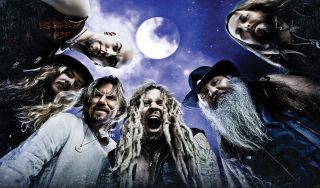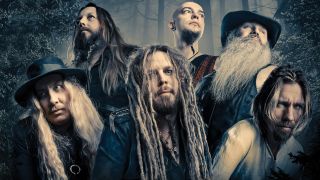When Korpiklaani roll up to Catton Park in August, two things are pretty much guaranteed. The first: they’ll get a huge crowd (Finnish? Folk metal? Bloodstock? Those things go together better than fry-ups and hangovers). The second: the songs the audience will know best will involve alcohol. Songs such as Beer Beer, Bring Us Pints Of Beer, Wooden Pints, Happy Little Boozer and of course Vodka – the closest they’ve come to having a hit, with the video racking up 15million views on YouTube.
So you could be forgiven for thinking most of the tracks on their new album, Noita, involve drink. But peer through the alcoholic fog and you may find a few surprises…
“There are a few songs about ‘noita’, which is ‘witch’ in English, but not like we nowadays think what witches are, because it’s more like ‘shaman’ or ‘healer’, in a way,” explains Jonne Järvelä, the band’s founder, guitarist, singer and main songwriter. “Because before Christianity, witches were – at least here in Finland – actually kind of like doctors, so they were really good. Then, when Christianity came, it turned into something ‘bad’ or ‘evil’.”/o:p
Not a mention of inebriation, intoxication or the imbibing of beverages in sight. In fact, while it may be what they’re best known for, drinking songs have only ever been one component of Korpiklaani – much like how Hail The Leaf doesn’t mean NOLA is an album full of songs about drugs and that Down only sing about weed. The cultural heritage and landscape of Finland are more integral than alcohol – more shamans than salmiakki (a dangerously drinkable spirit popular in Finland), if you will./o:p
“There’s a lot of lyrics about nature,” Jonne explains, in his hesitant but clear English, using the calm, amiable tone frequently present in the Finnish accent. “It’s something around us all the time, it’s been very near, because on the previous albums we were also dealing with nature on our songs. It’s maybe because we’re from the countryside and nature has been very close around us everywhere, all the time. That’s the main thing. We have a lot of drinking songs as well, because we like to drink and have fun – and this is a rock’n’roll band! So it’s always been quite a big role, but it seems bigger than it actually is – there have only ever been one or two drinking songs on the albums, and on the Noita album we also only have two.
“Somehow, the drinking songs are the more popular songs for Korpiklaani, so maybe that’s why people think the main part of the material is drinking songs,” he continues. “But it’s never been like that. I don’t blame people for thinking like that, because when we are at our gigs, people come to have fun. At those gigs we play quite a lot of drinking songs.”/o:p
To understand the band behind the bottles, you have to go back to their beginnings. The roots of Korpiklaani predate the current incarnation of the band by some distance. Back in the 1990s, Jonne was part of a folk act called Shamaani Duo, who played in a restaurant in a Lapland tourist resort. Later, this would become Shaman, the precursor to Korpiklaani, and a rather less accessible beast than now, inspired heavily by the music of the Sami (the people native to Lapland), such as yoik singing – a largely a cappella, rolling and highly distinctive vocal technique very unlike traditional European melodic singing.
The more recognisable version of Korpiklaani we see today first came to public attention with their debut album, Spirit Of The Forest, in 2003. They quickly established themselves, along with Finntroll, Ensiferum and later Turisas, as leading players of the folk metal wave about to sweep out of Finland and across Europe, with little in the way of an obvious ‘breakthrough’ moment or industry fanfare.
The power of underground word-of-mouth, plus the ease of discovery through the internet, meant the presence of Korpiklaani and Finntroll on the Bloodstock bill in 2007, and Turisas’s opening of Saturday’s Main Stage at Download the same year, were wise bookings rather than reckless gambles. That time Jonne spent as a folk musician in the Land of the Midnight Sun was hugely important in shaping the direction of the present-day Korpiklaani, who continue to dominate in a movement that shows no signs of losing momentum.
“There are still some shamans living there that can now do their work and don’t need to fear that they’ll be burned,” he explains, returning to the themes of Noita. “I met a few of them and it was an interesting world, back in the 1990s. The whole witch thing in Finland was so normal back in the day, and there are still many shamans living here. There is something really interesting in that whole thing.”/o:p

The lyrical significance is not the end of the story, however. The Finnish folk metal sound has some variations to it, but the basis is essentially the Hammerheart era of Bathory (the albums Quorthorn released between 1988-1991), and early Amorphis (1994’s Tales From The Thousand Lakes in particular – Finntroll, Ensiferum, Turisas and Wintersun all cite it as influential), mingled with humppa (a Finnish form of polka from the 1920s) and various other strands of folk music.
The whole thing is also given an adventurous, tale-telling character. Many bands are rooted more in the ‘metal’ side, with Ensiferum emphasising the Bathory epicness a little more than their peers, Turisas veering closer to the theatricality of power metal pomp, and Finntroll far more towards the ferocity of black metal.
The ‘folk’ constituent is often rather slim; Finntroll’s Vreth has said they are no longer sufficiently ‘folk’ to be described as a ‘folk metal’ band, for example. This is not the case with Korpiklaani, where the folk instruments play a more prominent role in the ensemble, and the tonal sense comes more from that side of the parentage than from metal. Again, Jonne believes his background in Lapland heavily influenced this aspect of the band.
“I think it’s a big role, because we are so different to many other bands,” he says. “We are not as black metal as many bands in this scene are, so maybe we’re the most ‘folk’ folk metal band. So it helps a lot to stand out, and people can hear something else. For example, our solos are not guitar solos – they’re played by violin or accordion. The folk instruments play a big role all the time, not just some little lines here and there.”/o:p
While there are bands who can make similar claims – Swiss outfit Eluveitie, for example, or China’s excellent Tengger Cavalry – Korpiklaani are unlikely to be out-folked by any band with electric guitars. This must surely be a sizeable part of why they survived folk metal leaving the novelty phase of its life cycle – 24 years since Skyclad effectively founded the subgenre with their pioneering debut The Wayward Sons Of Mother Earth, it’s no longer a curiosity that has just arrived, but an established branch of the family tree, and Korpiklaani’s nine albums in 12 years mean they’ve long since stopped being the upstarts of the clan.
Heavy metal no longer looks at hurdy-gurdy and accordion music in its midst and sees it as something strange or new, so the bands still getting attention and appreciation have to stand on merit more than ever. Korpiklaani’s folk authenticity must rank high among reasons they stand out, beyond just the quality of the songs. Not that the songs in English about drinking hurt…
Despite the success those tracks brought them, the band left behind the English language songs after 2009’s Karkelo – the album with Vodka on. The reason for this is rather more prosaic than you might hope, with no tales of secret desires to express things in a tongue closer to their hearts. Rather, Jonne acknowledges he is not the best lyricist (“I’m more a songwriter than a lyric writer”), and their main lyricist Tuomas Keskimäki only writes in Finnish. Only their most dedicated (or Finnish) fans now know what the songs actually mean – which is a shame, because there’s so much more to this band than songs about booze.
“It would be great if people could realise that,” says Jonne with a dry smile, “and maybe listen to the whole album, not just one song from Spotify.”
NOITA IS OUT NOW VIA NUCLEAR BLAST/o:p
WITCHFINDER GENERALS
Can’t understand what the folk Jonne’s singing about? He lets us in on one of Noita’s Finnish legends…
“The song Ämmänhauta is about a story from where I’m from – a little village called Vesilahti – where there was an old witch who wanted to be buried in the cemetery there. But it wasn’t possible for witches back in those times, because Christianity was already in Finland. People started to see witches everywhere; they started to hunt them and burn people they thought were witches. This one witch wanted to be buried, and they needed to do it secretly, at night. Her wish was that if you passed the grave, you needed to throw twigs or little pieces of wood on that grave, and nowadays there’s still a big pile of twigs and wood at that place, so the legend still lives on…”/o:p

